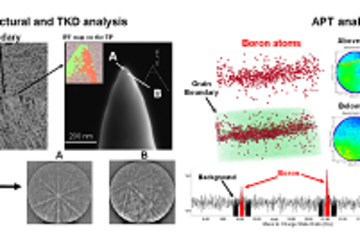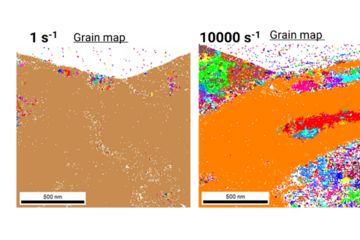All genres
361.
Journal Article
Microstructure and Phase Evolution of Niobium-Aluminide-Alumina Composites Prepared by Melt-Infiltration. Physica Status Solidi A 166 (1), pp. 241 - 255 (1998)
362.
Journal Article
The Influence of Chromium Addition on the Toughness of γ-Ni/α-Al2O3 Interfaces. Acta Materialia 45 (9), pp. 3503 - 3513 (1997)
363.
Journal Article
Synthesis of Analytical and High Resolution Transmission Electron Microscopy to Determine the Interface Structure of Cu/Al2O3. Ultramicroscopy 67 (1-4), pp. 207 - 217 (1997)
364.
Journal Article
A microindentation method for estimating interfacial shear strength and its use in studying the influence of titanium transition layers on the interface strength of epitaxial copper films on sapphire. Acta Materialia 45 (2), pp. 489 - 499 (1997)
365.
Journal Article
High Temperature Creep of Microcrystalline Dispersion Strengthened Copper Alloys. International Journal of Powder Metallurgy 33 (1), pp. 45 - 53 (1997)
366.
Journal Article
Transmission Electron Microscopy at the Max-Planck-Institut für Metallforschung. Zeitschrift für Metallkunde 87 (11), pp. 898 - 910 (1996)
367.
Journal Article
Retrieval of Crystal Defect Structures from HREM Images by Simulated Evolution. II. Experimental Image Evaluation. Ultramicroscopy 65 (3-4), pp. 217 - 228 (1996)
368.
Journal Article
Quantification of Irradiation Damage Generated During HRTEM with 1250keV Electrons. Ultramicroscopy 63 (1), pp. 49 - 55 (1996)
369.
Journal Article
Growth, structure and interfaces of Cu and Cu/Ti thin films on (0001)alpha-Al2O3. Materials Science Forum 207-209 (1), pp. 217 - 220 (1996)
370.
Journal Article
Influence of Interfacial Layers on the Ultimate Shear Strength of Copper/Sapphire Interfaces. Materials Science Forum 207-209 (2), pp. 597 - 600 (1996)
371.
Journal Article
Electron Energy-Loss Spectroscopy at Cu/Al2O3 and Ti/Al2O3 Interfaces. Materials Science Forum 207-209 (1), pp. 181 - 184 (1996)
372.
Journal Article
Measurement of Coherency States of Metal-Ceramic Interfaces by HRTEM Image Processing. Physica Status Solidi A 150 (1), pp. 77 - 87 (1995)
373.
Journal Article
Growth and Structure of Copper Thin Films Deposited on (0001) Sapphire by Molecular Beam Epitaxy. Philosophical Magazine B-Physics of Condensed Matter Statistical Mechanics Electronic Optical and Magnetic Properties 71 (6), pp. 1111 - 1124 (1995)
374.
Journal Article
Electron Energy-Loss Near-Edge Structure of Metal-Alumina Interfaces. Microscopy Microanalysis Microstructures 6 (1), pp. 19 - 31 (1995)
375.
Book
In-situ Electron Microscopy: Applications in Physics, Chemistry and Materials Science. Wiley VCH Verlag, Weinheim, Germany (2012)
376.
Book Chapter
In Situ μLaue: Instrumental Setup for the Deformation of Micron Sized Samples. In: Neutrons and Synchrotron Radiation in Engineering Materials Science: From Fundamentals to Applications: Second Edition, pp. 425 - 438 (Eds. Staron, P.; Schreyer, A.; Clemens, H.; Mayer, S.). wiley, Hoboken, NJ, USA (2017)
377.
Book Chapter
In-situ TEM Straining Experiments: Recent Progress in Stages and Small-Scale Mechanics. In: In-situ Electron Microscopy: SEM and TEM Applications in Physics, Chemistry and Materials Science, pp. 227 - 254 (Ed. Dehm, G.). Wiley VCH Verlag, Weinheim, Germany (2012)
378.
Book Chapter
Das Erich-Schmid-Institut für Materialwissenschaft (ESI) der Österreichischen Akademie der Wissenschaften. In: Handbuch der Nanoanalytik Steiermark, NanoNet Styria, 1 Ed., pp. 1 - 311 (Ed. Rom , W.). W. Rom, Graz, Austria (2005)
379.
Book Chapter
Sekundärionen-Massenspektroskopie (SIMS) mittels FIB. In: Handbuch der Nanoanalytik Steiermark, NanoNet Styria, 1 Ed., pp. 1 - 311 (Ed. Rom, W.). W. Rom, Graz, Austria (2005)
380.
Book Chapter
Fokussierte Ionenstrahl-Technik (FIB) in der Mikro- und Nanomechanik. In: Handbuch der Nanoanalytik Steiermark, NanoNet Styria, 1 Ed., pp. 1 - 311 (Ed. Rom, W.). W. Rom, Graz, Austria (2005)











